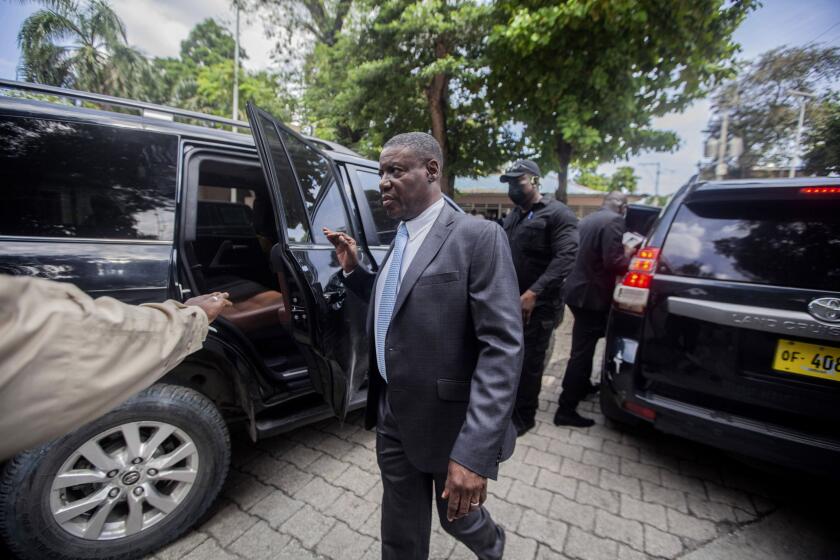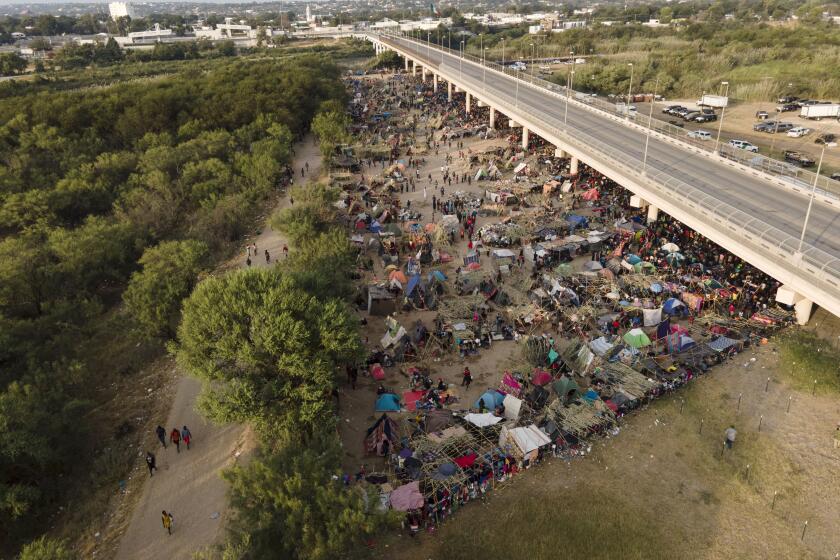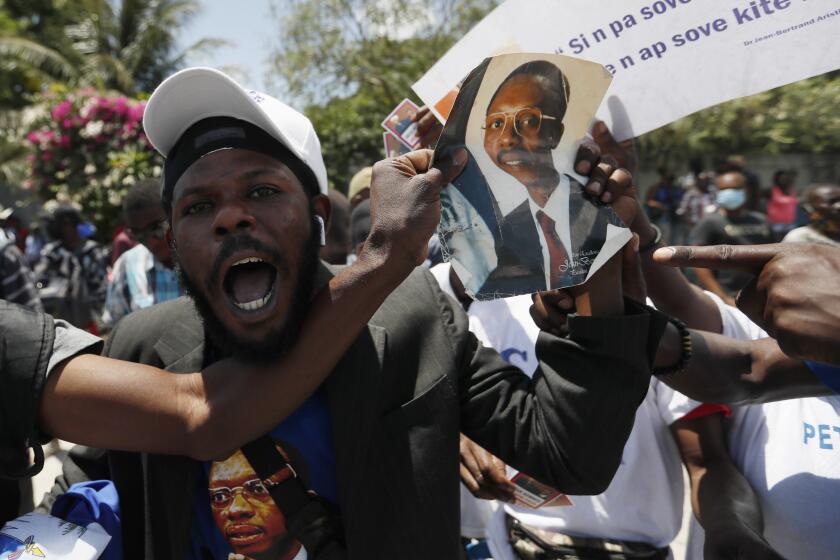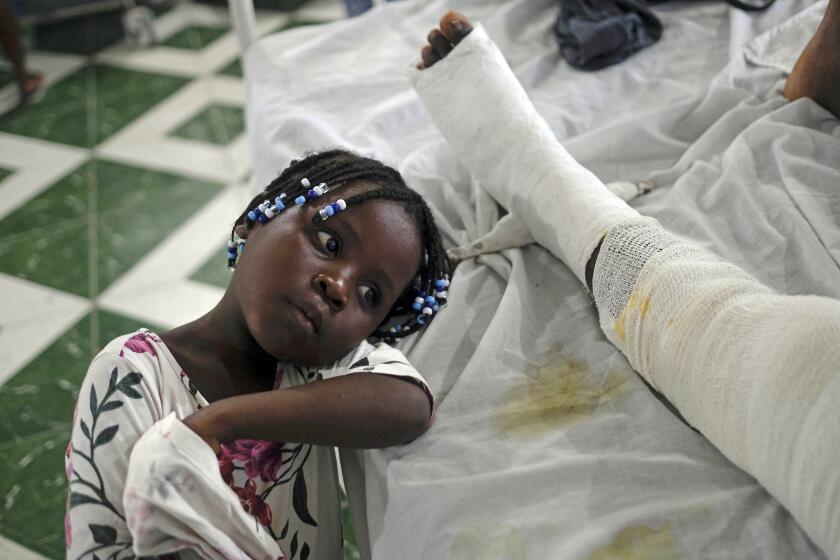‘The situation is out of control’: Gang power and violence suffocate Haiti

- Share via
PORT-AU-PRINCE, Haiti — The video shows more than 30 men lined up in front of a crumbling structure in silence. Their heads are bowed as a man walks between them and swigs from a small bottle. Someone exclaims, “There will be trouble in Port-au-Prince!”
Nearby, assault weapons are lined up against a wall, and two dozen handguns are scattered on the ground. Two large buckets are filled with bullets.
The men appear to be fresh recruits for one of Haiti’s most notorious street gangs, and the footage records their induction into the criminal underworld that increasingly rules the poorest nation in the Western Hemisphere. The video is emblazoned with the name “400 Mawozo” and “400 good for nothings,” both references to the gang that police say is responsible for multiple killings and kidnappings, including the recent abduction of 17 people from a U.S.-based religious group.
The footage posted earlier this year is a gritty online boast that demonstrates the startling power of Haitian gangs as they seize control of more land and commit more crimes than ever before — all without a care. Their tightening grip on society threatens the country’s social fabric and its fragile, anemic economy.
“The situation is out of control,” said James Boyard, professor of political science at Haiti State University, who, like other experts, accused some politicians and business owners of funding gangs. “They made them too powerful. Now they are terrorized. They didn’t know things would go out of control the way they did.”
Gangs control up to 40% of Port-au-Prince, a city of more than 2.8 million people where gangs fight over territory daily. The street that belonged to one group yesterday may belong to a rival group the next day. Two leaders who previously shot at each other may form a brief alliance against a third before becoming enemies again.
The leader of the 400 Mawozo gang that Haitian police say kidnapped 17 members of a U.S. missionary group is seen in a new video saying he will kill them if he doesn’t get what he is demanding.
There are dozens of gang names — Krache Difé, Torcel, Baz Pilot and 5 Secondes among them — but experts say only about 30 gangs are firmly established in the capital and surrounding areas. The largest and most powerful is thought to be the “G9 Family and Allies” federation of nine gangs, which is run by Jimmy Cherizier, a former police officer.
Gang violence waxes and wanes depending on the state of Haiti’s economy, its political situation and, at one point, the presence of United Nations peacekeepers. Currently, the country is still spinning from the July 7 assassination of President Jovenel Moise and a 7.2 magnitude earthquake that killed more than 2,200 people in August.
Those two events temporarily halted some gang activity, but kidnappings have surged in recent weeks. At least 328 kidnappings were reported to Haiti’s National Police in the first eight months of 2021, compared with a total of 234 for all of 2020, according to a report issued last month by the U.N. Integrated Office in Haiti.
The gangs’ growing power is most visible in the community of Martissant, which connects Port-au-Prince with the southern part of the country and is ground zero for at least three warring groups. The violence there has reached such extreme levels that many Haitians take hourlong detours to avoid the area, according to the local Le Nouvelliste newspaper.
Speaking publicly for the first time as Haiti’s new justice minister, Liszt Quitel pledges to find those responsible for high-profile killings.
Martissant’s abandoned police station is pockmarked with bullet holes, and bare-chested men with covered faces keep watch behind torched cars to ensure that no one approaches.
In July, a gang opened fire on an ambulance and killed a nurse. The following month, gang violence forced Doctors Without Borders to close its Martissant clinic. On a recent Saturday, a group of armored police vehicles tried to cross the area and were shot at. The body of a dead civilian lay on the ground for the rest of the day.
Until recent years, turf wars were usually between gangs, with civilians sometimes caught in the crossfire. Then in November 2018, more than 70 people were killed in La Saline, a seaside slum in Port-au-Prince currently controlled by the G9 federation, whose leader was implicated in the massacre.
“Retaliation started escalating ... so they started going after civilians,” said a top international official who was not authorized to speak to the media. “Now gang confrontations make no distinction between gangs and civilians.”
The doctors’ abductions dealt a major blow to attempts to control criminal violence that has threatened disaster response efforts in Port-au-Prince.
The same applies to kidnappings, which have targeted a hotdog vendor, priests, schoolchildren and wealthy business owners for ransom.
Experts believe much of this activity is driven by extreme poverty in a country where 60% of the population makes less than $2 a day and millions of people go hungry.
“Gangs are a way out, maybe the only way out, of that situation,” Boyard said.
The country’s GDP shrank 3.3% last year, the biggest decrease since the 5.7% drop that followed a devastating 2010 earthquake. In addition, the Haitian gourde depreciated more than 50% in the past year, and inflation remains above 10%, which has reduced purchasing power, said Haitian economist Enomy Germain.
U.S. Special Envoy to Haiti Daniel Foote resigned with a scathing letter criticizing the treatment of Haitian migrants and deportations from a Texas border camp.
This situation is comparable to the period that followed the 1991 coup that toppled former President Jean-Bertrand Aristide, Germain said.
Experts blame Aristide for creating the current gang phenomenon. After returning to power in 1994, they say, he disbanded the army and began arming people in slums, many of whom he had influenced during his time as a Roman Catholic priest.
Some gang recruits start as young as 6 or 7 and by their late teens occupy high-ranking positions. Few survive to 30. Members often refer to themselves as “soldiers.” An armed man who identified himself only as James said he is a mechanic and joined the Baz Pilat gang “to protect the ghetto from rivals that enter to steal, kill and rape.”
Gangs also choke Haiti’s economy by blocking gas distribution terminals and major transportation routes — moves that prevent goods from flowing through the country. Many gas stations now remain closed for days at a time.
Former President Jean-Bertrand Aristide has returned to Haiti after nearly a month in Cuba.
“I’m living in a chaotic country,” said Delmy Belmon, a 44-year-old manager at a hardware store. He said his children, 9 and 12, can’t go outside to play and are old enough to understand what is going on.
“Whenever they are in the car, they are looking right and left, and when motorcycles approach the car, I can feel they are scared,” he said.
Violence is expected to worsen as Haiti prepares for presidential and legislative elections scheduled for next year. Political groups have long been known for paying gangs, according to the top international official.
“Any gang is open for negotiation and purchase,” the official said.
Start your day right
Sign up for Essential California for the L.A. Times biggest news, features and recommendations in your inbox six days a week.
You may occasionally receive promotional content from the Los Angeles Times.
Haiti has roughly 9,000 police officers on the streets, a fraction of the number that would normally patrol a country of more than 11 million people.
Gangs outnumber police and carry more weapons. Earlier this year, they killed at least four officers and wounded several others following a botched anti-gang raid in the Village de Dieu slum.
Days later, police marched through the streets to demand the return of their colleagues’ bodies. The officers belong to a disgruntled sector called Fantom 509, which has been accused of killing people, setting buildings ablaze and even storming a jail to free imprisoned comrades.
Some officers with Haiti’s National Police also have ties to gangs, Boyard said. “They support them, tell them how to move, when to go out and when to go in,” he said.
After Haiti’s devastating earthquake, a difficult question: How do you turn over hospital beds when discharged patients have no place to go?
A spokeswoman for Haiti’s National Police did not return a message seeking comment.
Meanwhile, André Apaid, a Haitian businessman who owns a large textile company, declined to say whether he pays gangs but noted: “Business coexists with criminal and violent structures in order to survive.”
Gang activity is “a poison for an economy,” Germain said. “We cannot talk about economic recovery if we don’t have security, if people are kidnapped every day, if freight trucks are hijacked by gangs every day, if enterprises cannot freely carry out their activities.”
More to Read
Sign up for Essential California
The most important California stories and recommendations in your inbox every morning.
You may occasionally receive promotional content from the Los Angeles Times.
















